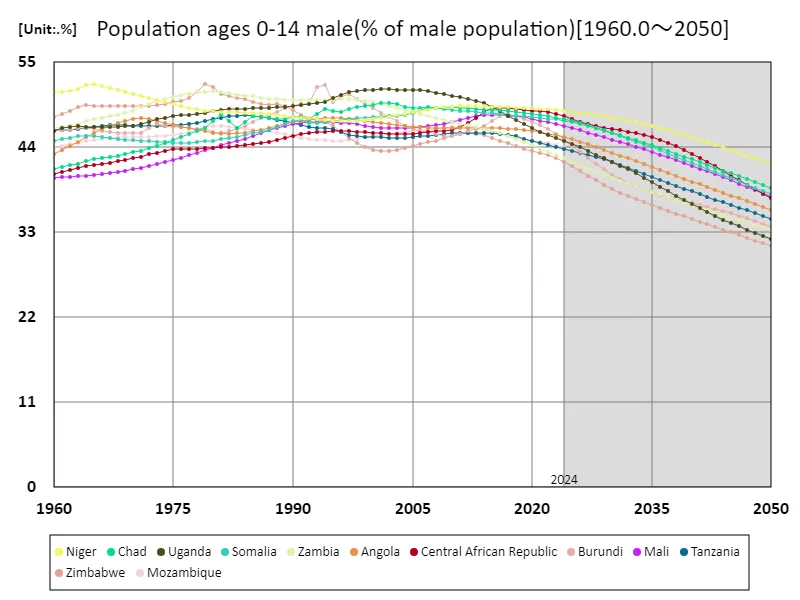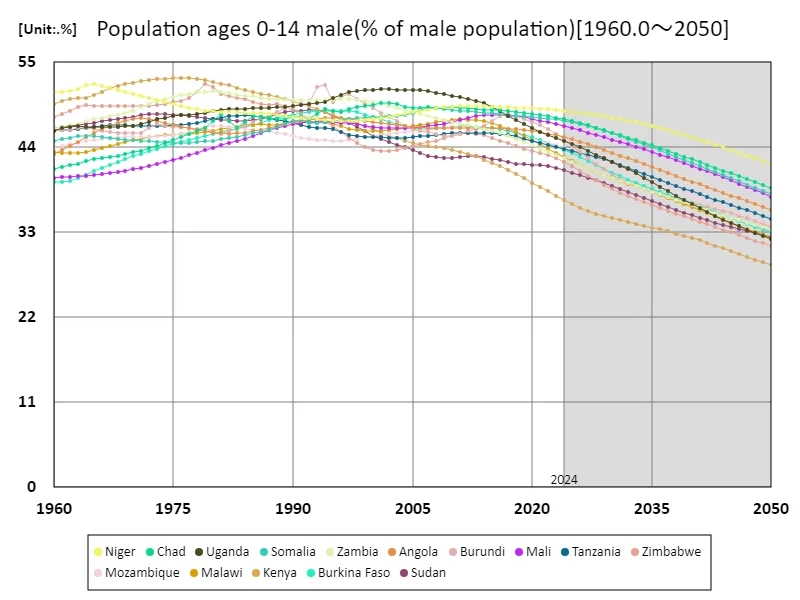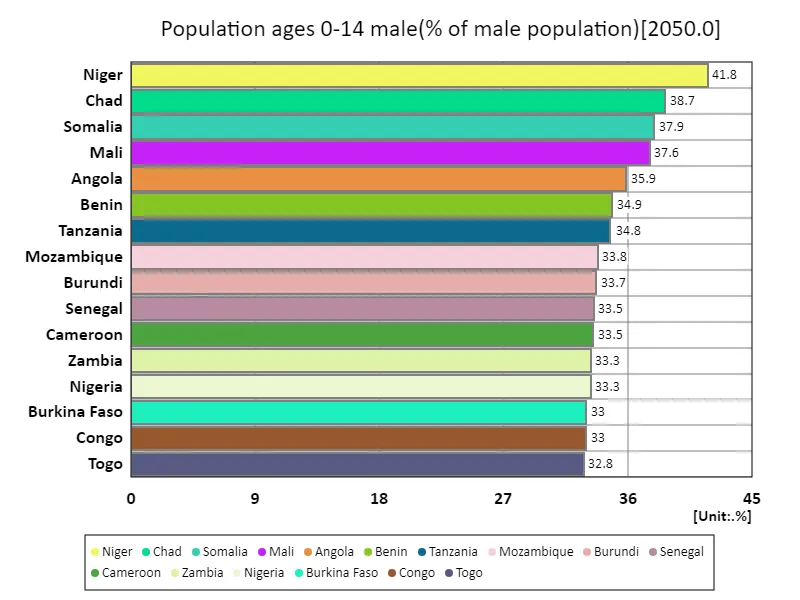Abstract
Niger’s predicted male population share for 0-14 year olds will be highest at 41.8% in 2050, reflecting the country’s unique demographics. Niger is characterised by a high fertility rate and rapid population growth, which has led to a high proportion of men in this age group. Over the past few decades, Niger has experienced a very high birth rate, with an increasing proportion of young people living with limited access to education and health care. This has resulted in Niger having a social structure with a young generation in the majority, which is expected to create an increased demand for employment, education and social services in the future. In particular, in order to achieve economic growth and stability, it is urgent to improve education and vocational training for young people.
Males aged 0-14 years (percentage of male population)
The proportion of males aged 0-14 in Niger peaked at 52.1% in 1965 and has since declined to 80.2%, illustrating demographic changes. In the 1960s, Niger had a very high birth rate and a high proportion of young people, making the entire society young. Subsequently, with improvements in medical care and the spread of education, the birth rate gradually decreased and the population structure changed. Especially since the 1970s, as the population has aged, the male population ratio for those aged 0-14 has begun to decline. Niger’s declining youth ratio will have a major impact on the country’s economic development and social change, and addressing an ageing society will be important in the future.


The maximum is 52.1%[1965] of Niger, and the current value is about 80.2%
Males aged 0-14 years (percentage of male population) (Worldwide)
Kenya’s male population ratio for 0-14 year olds peaked at 53% in 1976 and remains high at 54.3% today, illustrating the country’s unique demographics. In the 1970s, Kenya was characterized by a high birth rate and a large young population, which contributed to a high proportion of males aged 0–14 years. The reason for this high ratio in recent years is Kenya’s still high birth rate and rapid population growth. Despite improvements in education and health care, the high proportion of young people means there is a high demand for education, health and welfare services for children and adolescents. Future challenges include providing appropriate educational opportunities and creating jobs for the rapidly growing young population, and policies that address these needs will be required to achieve sustainable economic growth and social stability.


The maximum is 53%[1976] of Kenya, and the current value is about 54.3%
Males aged 0-14 years (percentage of male population) (Worldwide, latest year)
According to data for 2050, Niger’s male population ratio for ages 0-14 will be 41.8%, the highest overall. This indicates that Niger continues to have a very high birth rate, with a prominent proportion of young people. The average is 20.9%, while countries like Niger far exceed this figure and have a large youth population that makes up a large proportion of their society. In the past, many developing countries, including Niger, have had high birth rates and rapid population growth, but in recent years, birth rates have been declining due to economic development and the spread of education. Niger’s high rate reflects its still-high birth rate, and education, health and employment issues for this young generation will be important challenges in the future. The overall total of 4.11% suggests that the concentration of young people has a major impact on economic policy, calling for appropriate policy responses.


The maximum is 41.8% of Niger, the average is 20.9%, and the total is 4.07k%
Males aged 0-14 years (male population ratio) (region, latest year)
According to data for 2050, the Central African Republic will have the highest proportion of males aged 0-14 years at 37.4%, reflecting the country’s unique demographics. The Central African Republic continues to experience high birth rates and rapid population growth, resulting in a significantly higher proportion of young people. On the other hand, with the average being 22.2%, the population in many countries is aging and the proportion of young people is declining relatively. The total figure of 333% shows how high the proportion of young people is compared to the international average, which has a significant impact on the social structure of the Central African Republic. Over the past few decades, many developing countries have experienced high birth rates, while at the same time, economic development and improved education have led to declining birth rates. In countries with a high youth population, such as the Central African Republic, there is a high demand for education and health services, and future economic growth will require policies that address these needs.


The maximum is 37.4% of Central African Republic, the average is 22.2%, and the total is 333%



Comments